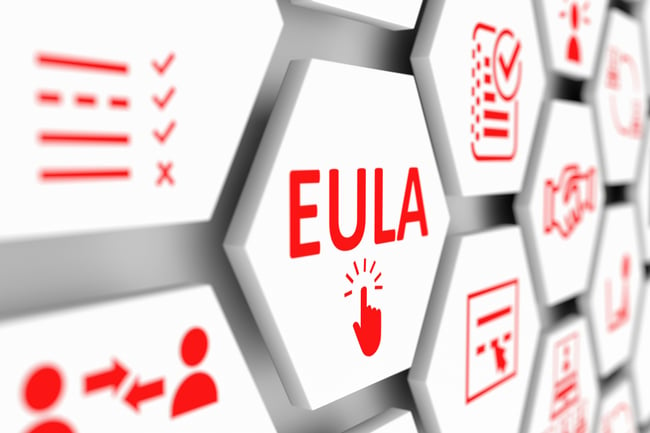The difference between an End User License Agreement (EULA) and a Software License Agreement (SLA) depends on intended usage. The EULA generally governs the continuous use of the software by a group of individuals. Meanwhile, an SLA targets a specific entity for a finite period. Of course, other nuances distinguish the agreements, but these are the two primary variances.

These kinds of agreements have recently gained attention due to the accelerating digital transformation in business and society that requires companies and individuals to utilize more apps and software platforms. Ensuring appropriate use and protection is necessary to limit liability and protect intellectual property—however, contract provisions must change based on the license type. In either case, artificial intelligence (AI) can help corporate legal departments ensure that their company’s assets are protected.
The Difference Between a EULA and a Software License Agreement
Understanding the difference between a EULA and a Software License Agreement is critical when deciding which type of contract to use. EULAs typically include an intermediary, whether the individual buys the product from a retailer or platform. For instance, a EULA would be required when releasing an app for general use in the App Store or on Google Play.
An SLA, on the other hand, governs a direct connection between businesses. In the case of an SLA, the software would be installed and operated on the licensees' hardware, and the original creator would retain software ownership and significant control over its use.
Of course, as more companies turn to cloud computing and online platforms, the SLA has been replaced with the SaaS (Software-as-a-Service) agreement. Since these are similar agreements, many of the provisions that apply in an SLA also work equally well with a SaaS agreement.
Contract Differences Between a EULA and an SLA
The differences between a EULA and an SLA are evident in the language and purpose of each.
EULA
|
SLA
|
|
The EULA controls use and limits liability. In some cases, a EULA can circumvent copyright limitations. It is often an adhesion contract presented to users with a "take it or leave it" requirement. They must either accept the terms—usually through a clickable "I agree" button—or decline and not use the software. Common clauses include:
- IP definitions
- Liability limitations/hold harmless clauses
- Limited warranties
- Usage restrictions
|
The SLA can vary widely—governing free or paid options, as well as private or public uses. However, it generally focuses on limiting threats to the source code. In most cases, SLAs grant the end-user access to a fixed number of software copies for a finite period. Agreements include clauses like:
- Copyright retention
- Copying, displaying, and distributing rights
- Modification restrictions
|
Both the EULA and the SLA present challenges in contract drafting and negotiation. A EULA may be too ambiguous to be enforceable, which is always a significant risk in adhesion contracts. Meanwhile, the SLA may miss key provisions that preserve its copyright and limit modifications. In both cases, AI legal technology can help legal departments meet these contract challenges.
Managing Licensing Agreements with AI
For corporate legal departments, an AI-powered contract review and negotiation tool can prove extremely valuable. While an attorney could review these contracts manually, it might require hundreds of hours. Meanwhile, AI-driven contract review reads through these licensing agreements en masse, parses their language, and compares them to other completed contracts. The AI returns a marked-up version of the agreement noting areas of concern and suggesting textual revisions to strengthen contract provisions. Moreover, all this occurs in minutes.
AI contract review is particularly valuable when applied to renewals and updates, which are extensive in software licensing. The AI reviews and updates contracts with the same care that an actual attorney would provide. Areas of concern are located and flagged, even in instances where thousands of contracts require management.
While there are many differences between a EULA and a Software License Agreement, they both serve a common purpose by protecting the intellectual property that companies develop. Legal departments that use a contract review tool powered by AI are ensuring that the right provisions are in place to maintain protections while streamlining the contract lifecycle management process.
Because LexCheck's AI-powered platform understands the difference between a EULA and a Software License Agreement, it can streamline your software licensing review and negotiation process. To discover the benefits of technology-enabled contract management, request a demo or reach out to us at sales@lexcheck.com.
.jpg)
